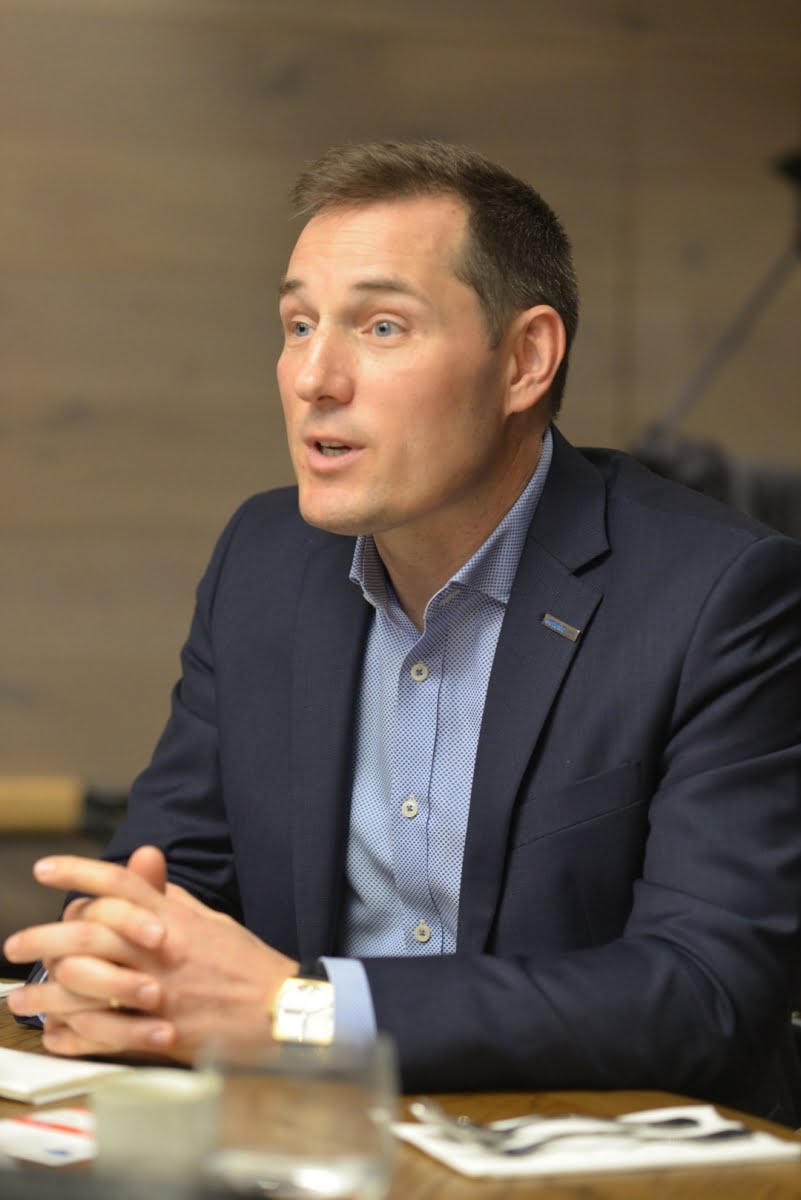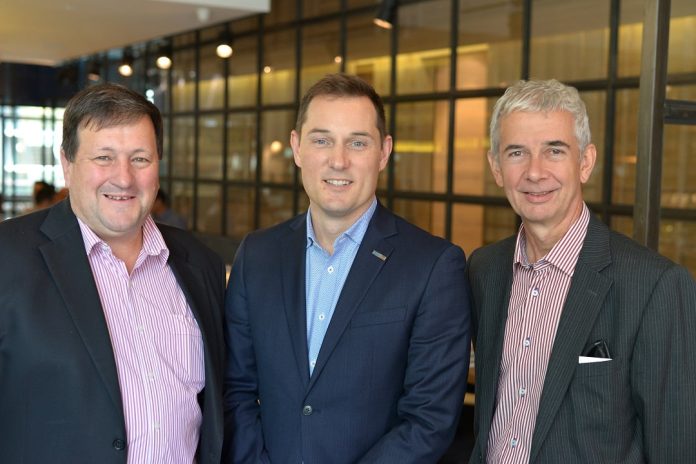Genetec is leaning into the Australian market, enhancing its relationship with local distributor Hills and expanding the team on the ground as its local business and its product portfolio continue to grow. John Adams spoke with Genetec’s Charles Cousins, MD Asia Pacific Japan, new country manager Philippe Ouimette and Hills’ David Lenz about plans for growth.
Q: Could you give readers some background of the Genetec history in the Australian market?
Charles: Genetec got involved in 2009 – at the time Genetec was distributed in Australia by OPS, which was getting blue chip customers and had grown from 4 staff to 30. OPS was then acquired by Hills and we have successfully partnered with Hills.
For the last 2 years the growth has been in high double digits – much faster than the market it growing. We now want to inject more activity into the Australian market. We have appointed a country manager from Genetec in Montreal, Phillipe Ouimette. Phillipe joined Genetec 3 years ago and being married to an Australian and having worked in Australia for 3 years in the late 90s, he made it clear when he joined he was happy to work in Australia if an opportunity came up, which it did. Phillipe inherits a successful Genetec business with high visibility.
What we like about the Australian market is the similarity in security values to Canada and the U.S. – in Asian markets the first criteria is price, the second is price, the third is price. Here it’s reliability, robustness, redundancy, support and perhaps then you get onto price. We see so much momentum, a fabulous pipeline, great products coming out of Montreal – we are looking to move way beyond the ability to record and playback. It’s the right time to have a new country manager to drive it forward.
Q: How does Hills feel about Genetec’s investment in increased staff levels? For some time boots on the ground was engineering support – will this assist the Hills effort?
David Lenz: Yes, it certainly will. From Hills’ perspective we are very excited about the future of the Genetec and Hills partnership in Australia. From our point of view there has been a lot of investment in the brand and we are seeing complementary investment from Genetec that will make us even stronger in the market. We have a good strategic fit and Genetec has some very clear goals about how they plan to assist with facilitating growth in the market. We’re excited about the investment taking place. Thanks to the Genetec SDK there is the ability to do more locally in terms of development – Genetec goes about the process of integrating development in a very structured way – what we do here goes back onto the world stage.

Q: What has your role been since joining Genetec, Phillipe?
Phillipe: For the last 3 years I was director of the global alliance team, which is essentially taking care of all the technical partnerships we have around the world. I joined the company 3 years ago and was employee 600 and we are about to break 1000 employees so there’s been a lot of growth in the past 3 years. It’s changing and it’s growing – how do we grow while maintaining that innovative start-up mentality moving forward, that nimbleness.
We think about these things on a day to day basis – we think about structuring the company in a way where it is driven by transversal applications, to grow but to retain what we call villages within the company – these teams – we hope to keep that spirit of innovation, ability to pivot quickly – being a private company we have a lot of that ability to be able to respond quickly to the market.
Q: Could you outline the plans for the Australian market?
Phillipe: The idea is that as Genetec accelerates its business what we are seeing is that Genetec is known in the region as a VMS platform and a lot of our sales are driven from that area but the platform is evolving and it’s now much more than that. How do we work with our partner to be better equipped to sell the whole portfolio of Genetec products? How do we educate the market so it can better absorb that technology?
Bridging that gap will be a big focus of the next 3 years. Where the industry is moving is towards connectivity, IoT – IP video was IoT before that name was coined. As we start connecting more intelligent devices to our platform it becomes more than the sum of its parts and this accelerates the types of products we are bringing to market – educating the market on where we are now is a big part of why we are injecting resources into the Australian market.
It's good for the company and good to have ties into the office in Montreal, to keep the engineers on top of what’s happening in the Australian market, the uniqueness of the market and how do we build that into the products going forward – so part of the role is being that interface between Australia and Canada. Our R&D is in Canada – we have more than 300 engineers working on our software development – they’ve been focused on core products but we now have other applications other than physical security. We also have around 100 engineers on Paris, France.
Q: What’s the percentage of lateral applications- applications outside the traditional security video surveillance market?
Phillipe: It’s considerable – we’re not trying to take them all on at once but we have launched an out-of-the-box solution in the retail business that will be announced early next year – you still need existing cameras and a VMS to support this product but it will give intelligence to be fed back to the marketing department to enhance retail sales. The data is there but is not available in a digestible format. There will be charts and graphs that will be generated automatically.
For instance, when we think of airports, we don’t just think of security – we are thinking of passenger flow through the airport, how do we help retail outlets be more efficient, how do we improve management of parking facilities, how do we help baggage handlers work more efficiently. For instance, we have 7 software engineers in our SDK development team. There are many universities in Montreal so it’s easy to find capable software developers.
There are now products including Mission Control, which ties all the information coming from data points, including cameras, access control, LPR, alarm inputs, voice communications and guides an operator through a series of procedures. We have digitised procedures so that operators faced with particular situations are guided to the appropriate response by the software. It can be used for training, for auditing of performance. It takes the emotion out of decision making.

Q: Cloud is a major focus for Genetec and has been for some years. What are the plans there?
Phillipe: As we keep developing new products we continue our focus on cloud first. Security Center has traditionally run on-premise but today Security Center is available in the cloud on a subscription basis. It allows you to offset computing costs to the cloud, saving on energy costs, space. It’s a change for the enterprise space. It’s supported by Microsoft Azure, which has just opened a new data centre here in Australia.
Having a cloud first model allows us to bring new products to market more quickly. One of the latest products we have released, called Clearance, is a totally cloud-based digital evidence management platform for law enforcement customers. Law enforcement needs to correlate video from body worn cameras with mobile phone footage from bystanders, adjacent surveillance cameras and the like. Clearance allows them to do this in the cloud securely. It’s agnostic, standalone, can be run on any VMS, authenticates users, creates an audit trail so you can see who has accessed the video.
Q: Where do you see growth in cloud?
Phillipe: Our first cloud product was Stratocast and over the past 2 years it has taken on a life of its own. An example is Project Greenlight in Detroit, a city which has a problem with crime so that even the mayor expressed fear of going to a service station for fear of getting mugged. The city wanted CCTV but was bankrupt. So the idea was to approach private businesses to subscribe to Stratocast and then federate those video streams back to a central police station for monitoring.
Service stations connected with Project Greenlight are provided a solid green light to display out the front of their premises. Customers feel safer stopping there because they know police are watching. Outlay costs are low as the cameras are already installed, there was no cost to the city. The subscription costs are also low, so everybody wins. We see this model replicating itself – it’s already starting to mushroom.
Charles: A similar application is installed in Mongolia where they have odd-number and even-number days to mitigate traffic congestion. If an odd number is seen on an even number day, footage is sent to a control room for actioning. In NZ, we looked at a project that was designed to monitor vehicles that were circling particular sensitive sites. There’s no end to such applications.
Q: Is your development customer-driven or are there other inputs into the product pipe?
Phillipe: Certainly yes but sometimes no. Genetec was a pioneer – we have been in IP video for 20 years. Back then, people thought it was silly to stream IP video over networks, but the industry has changed. The same thing applies to cloud today – 5 years ago, people said cloud could not be done but things have changed and it now is possible to manage CCTV using cloud. We are an innovative company – we see ahead – so that means we don’t always listen to the customer – instead we look ahead to see where the industry is going. The security industry is a little conservative, after all.
Q: What sorts of products or functionalities did Genetec customers prompt?
Phillipe: Huge numbers off functionalities and all the time. Retail analytics is a key thing. Retail loss managers were looking for a greater ROI on their surveillance systems. Same applies to Mission Control – Customers were getting video streams and wondering what’s next. Video is fundamental to most security procedures – alarm events, fire alarms, access control exceptions. Video is now integral.
Charles: Of course, systems sold today incorporate the capabilities of everything everyone has learned and integrated into their system over many years product development – people are not reinventing their systems but sharing the best operational capabilities between them.
Q: Is there anything you’d like to say to integrators, consultants and end users in the Australian market – what can they expect from Genetec in 2017?
Phillipe: We are excited about where things are going – we are growing, we are investing in Australia and we are looking forward to bringing new products to market in Australia. We have added the ability to bring together large applications, we’ve added some BDM capability – you’ll be hearing a lot more from us over the next 12 months. ♦












